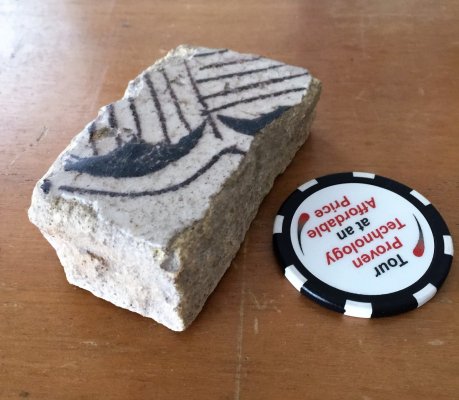Midpack
Give me a museum and I'll fill it. (Picasso) Give me a forum ...
I was on someone's thread elsewhere how was asking about returning antiquities, and thought I'd throw my example out here. I think I mentioned it years ago, but it never went anywhere. Never hurts to ask, there are some incredibly resourceful people here.
I tried to return an "antiquity," but gave up. As a teenager in the late 60's, I picked up a piece of fired or painted tile from the track itself at Circus Maximus in Rome, noticed it buried just under the surface and dug it up and put it in my pocket. There is no question in my mind that it's very old, though I have no idea if it was original with Circus Maximus. I still have it today. A few years ago I asked about returning it, and I got such a convoluted runaround I just quit trying. I have no idea what it's worth, probably little or nothing. I would love to know what it came from, but I don't expect I will ever know.
It's about 1½" x 3", the poker chip is just for scale.
I tried to return an "antiquity," but gave up. As a teenager in the late 60's, I picked up a piece of fired or painted tile from the track itself at Circus Maximus in Rome, noticed it buried just under the surface and dug it up and put it in my pocket. There is no question in my mind that it's very old, though I have no idea if it was original with Circus Maximus. I still have it today. A few years ago I asked about returning it, and I got such a convoluted runaround I just quit trying. I have no idea what it's worth, probably little or nothing. I would love to know what it came from, but I don't expect I will ever know.
It's about 1½" x 3", the poker chip is just for scale.
Attachments
Last edited:

